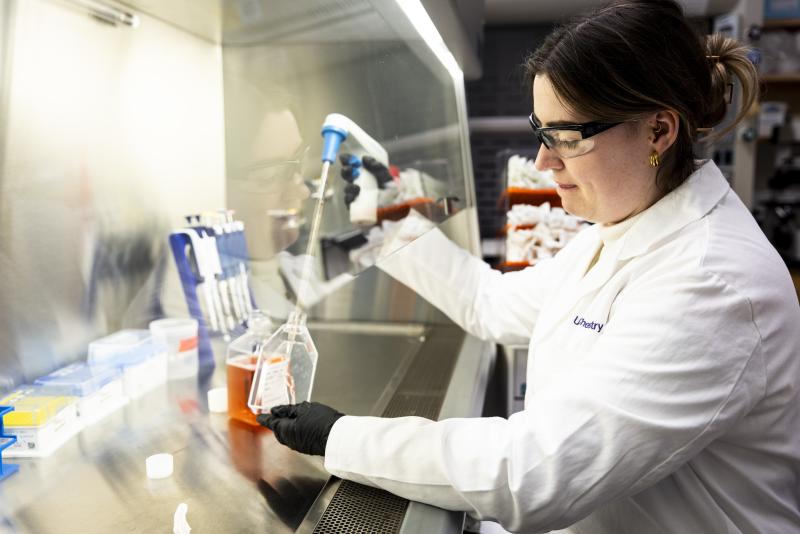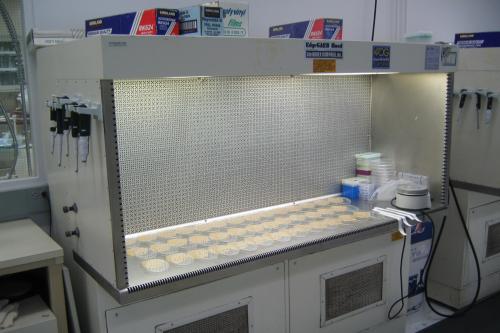October is Biosafety Month, a time to focus on biosafety practices in your lab. For 2025, Environmental Health & Safety (EH&S) encourages labs to learn more about how biosafety cabinets provide protection and how to safely use one.
A biological safety cabinet (BSC), also referred to as a biosafety cabinet, is an enclosed, ventilated workspace used as an engineering control to protect personnel, products, and the environment. It creates an air curtain to provide containment and a sterile work environment.
How a BSC provides protection
Contaminated air within the cabinet passes through high efficiency particulate air (HEPA) filtration systems before exhausting or recirculating.
There are three classes of biosafety cabinets; the most commonly used in labs are Class II. Class II cabinets have an open front with inward airflow to protect personnel, downward HEPA-filtered airflow over the product, and HEPA filtration of exhausted or recirculated air.
- Recirculated air means that around 30% of the air passes through the HEPA exhaust filter at the top and is recirculated into the room or removed by canopy exhaust.
- The other 70% of air passes through the supply HEPA filter and flows back down to the work surface. Any recirculated air is HEPA-filtered and not contaminated.
Complete the online Biosafety Cabinet Safety Training to learn more.
Annual recertification
Annual recertification is critical to ensure your biosafety cabinet is in good working condition to contain biohazardous aerosols. EH&S recertifies BSCs annually; the EH&S Biological Safety Cabinet Program will contact you to schedule recertification. You can contact them for any issues with your BSCs at labcheck@uw.edu or 206-543-9510.
Work safely in a BSC
- Turn on the BSC so that the blower can run while you gather items for work.
- Plan for items needed inside the BSC, and limit to only what you need to reduce clutter.
- Do not obstruct the front grill or back vent of the BSC as this will inhibit airflow.
- Work at least 6 inches inside the cabinet.
- Ensure the sash is at the correct height during operation and that you are able to sit and work comfortably for proper ergonomics.
- Wear a lab coat and gloves pulled over the cuff/wrist of lab coat.
- Set up a workflow to move from a clean to dirty direction to prevent contamination.
- Use slow, controlled motions while working in the BSC; move in and out with perpendicular movement to avoid disturbing the air curtain.
- Disinfect the BSC before and after each work session. Use 70% ethanol or water after disinfectants to prevent corrosion or remove residues.
- Disinfect surfaces of items removed from the BSC.
- Do not work in a BSC during a ventilation shut down or while the BSC is alarming
Disinfecting a BSC may seem straightforward, but it is easy to do improperly. Follow these steps to disinfect your BSC properly:
- Turn on the BSC to purge stagnant air.
- Don PPE including a lab coat and gloves. Eye/face protection may be warranted based on biological agents used in the BSC.
- Ensure the sash is set to the appropriate height. Do not disinfect with the sash lifted past the indicator for appropriate height.
- Disinfect all surfaces including the walls and interior of the glass pane.
- Disinfectants selected should be agent-appropriate.
- Use a squirt bottle or wet wipes. Do not spray disinfectant inside the BSC; aerosolized disinfectants can lead to corrosion or damage the HEPA filters or mechanical components.
- Use a tool such as an extendable wet mop or reach assisting tool to reach all surfaces. Do not place your head inside the BSC.
- Disinfected surfaces should be wet for the full contact time per the manufacturer’s instructions.
Deeper cleaning
Deeper cleaning procedures include cleaning the spill tray underneath the work surface. Lift or remove the work surface to clean the spill tray where spills, dust, and items such as broken glass can accumulate and ultimately lead to contamination events if not adequately cleaned. How often a BSC should be deep cleaned depends on how heavily and frequently it is used.
Decontamination
BSCs must be decontaminated by EH&S before service, relocation, or surplus. Review the Steps to Purchase, Replace, Relocate or Remove a Biosafety Cabinet for more information.
Look-alikes
Other equipment may resemble a biological safety cabinet but does not provide the same level of protection for the personnel, environment, or product. The following equipment should not be used as a substitute for a BSC when working with biohazards:
- Laminar flow hoods or clean benches prevent contamination of the product but offer no protection from biological contamination to personnel or the environment.
- Fume hoods offer robust personnel protection from chemicals but are not designed to offer product protection and do not have HEPA filtration of exhausted air.
- Cage change stations offer protection against allergens but do not contain or offer protection from infectious agents.
This laminar flow hood does not provide containment or protection from biological contamination to personnel or the environment
Questions?
For questions related to working safely in a biosafety cabinet, contact the EH&S Biosafety team.
For assistance with biosafety cabinet purchasing, moving, certification, or decontamination, contact the EH&S Biological Safety Cabinet Program.

